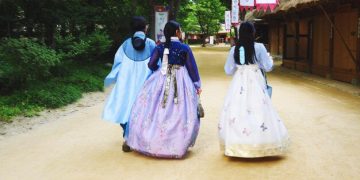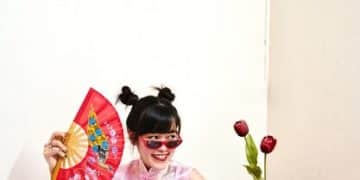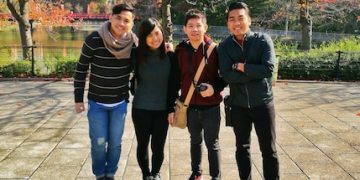Traditional Korean festivals that you must experience
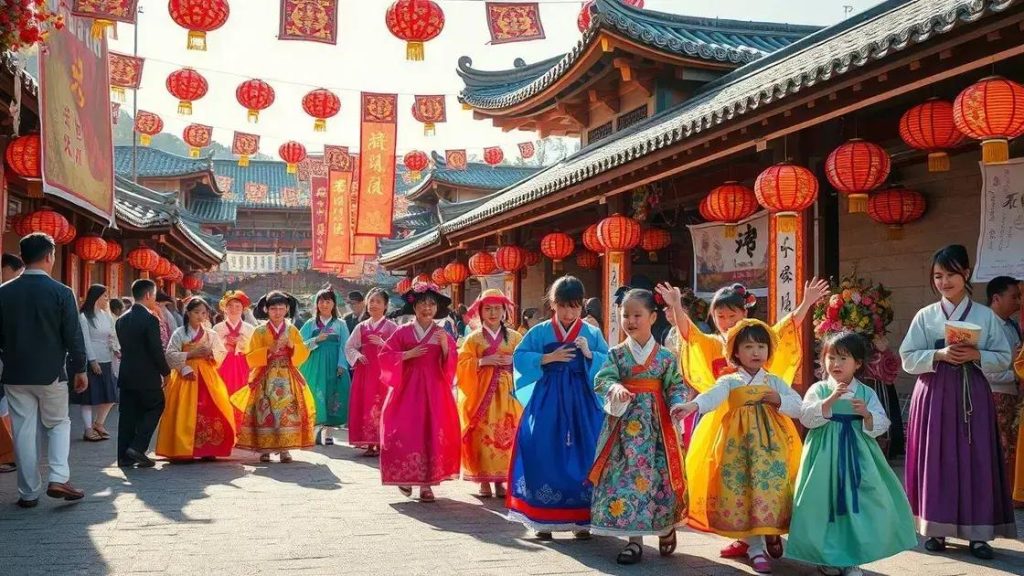
Traditional Korean festivals such as Chuseok, Seollal, and Boknal offer immersive experiences that celebrate culture through food, rituals, and community activities, allowing participation while respecting local customs.
Have you heard about the vibrant traditional Korean festivals? These unique celebrations reveal the heart of Korean culture, providing insight into its rich history and traditions. Join me as we explore the lively events that showcase the spirit of Korea.
Overview of traditional Korean festivals
Traditional Korean festivals are vibrant celebrations that embody the rich history and culture of Korea. These festivals offer a glimpse into the traditions that have shaped the Korean way of life.
Key Characteristics of Korean Festivals
Each festival showcases unique customs and practices, reflecting the different aspects of Korean culture. You’ll find colorful costumes, traditional music, and exciting performances during these events.
- Chuseok: A harvest festival celebrating family and gratitude.
- Seollal: The Lunar New Year, marked by rituals and celebrations.
- Boknal: A summer festival dedicated to eating nutritious dishes for health.
These festivals not only promote cultural pride but also provide an opportunity for communities to come together. People engage in various activities such as dancing, cooking special foods, and paying respects to ancestors.
Importance of Cultural Preservation
By participating in traditional festivals, individuals play a crucial role in preserving their heritage. This ensures that future generations understand their roots and appreciate the significance of these occasions.
Attending festivals like Chuseok or Seollal is a great way to experience the collective joy of the Korean people. You’ll see families coming together, sharing traditional meals, and enjoying the festive atmosphere that envelops the country.
Overall, traditional Korean festivals offer not just entertainment, but a heartfelt reminder of community and tradition. They allow participants to connect with one another and with their history in meaningful ways. Whether it’s through music, dance, or food, there’s something for everyone to enjoy during these lively celebrations.
Key festivals celebrated in Korea
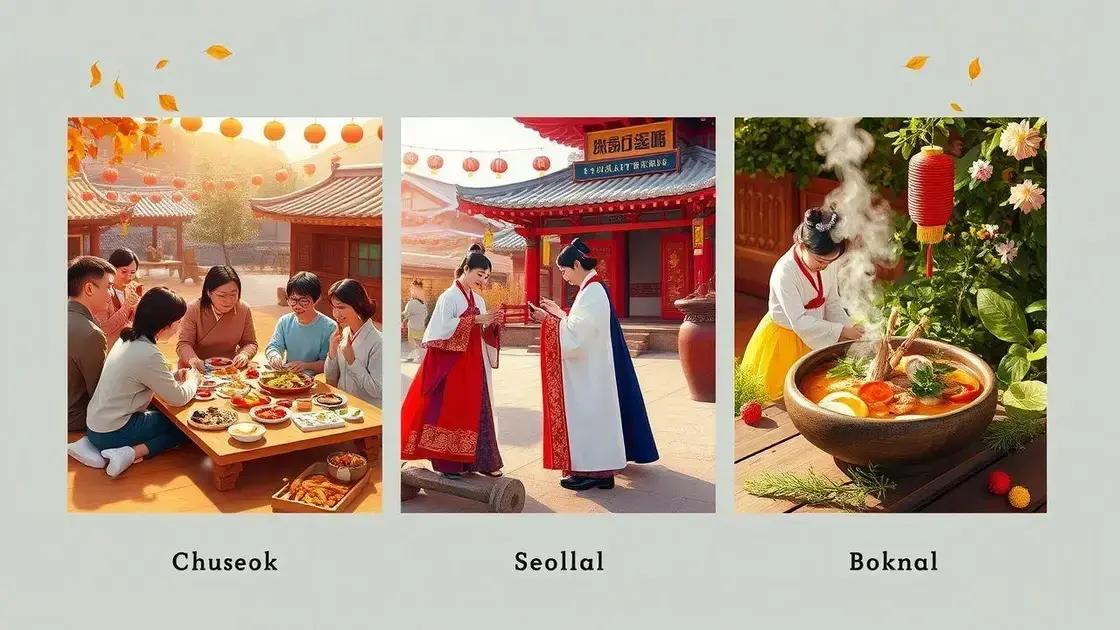
Korea is home to several unique and exciting festivals that highlight its rich culture and traditions. Each festival has its own history and significance, making them meaningful events for locals and visitors alike.
Chuseok
One of the most important holidays, Chuseok, is a harvest festival celebrated in the fall. Families come together to honor their ancestors and share special foods, like songpyeon, a type of rice cake filled with sweet ingredients.
- Time of year: Celebrated in September or October.
- Activities: Ancestral rites, family gatherings, and traditional games.
- Special foods: Songpyeon and various seasonal dishes.
This festival is a time of gratitude and reunion.
Seollal
The Lunar New Year, known as Seollal, is another significant celebration in Korea. Families honor their ancestors and wish for a prosperous year ahead. One popular tradition is wearing hanbok, the traditional Korean dress.
- Time of year: Celebrated in January or February.
- Activities: Rituals to honor ancestors, family feasts, and games.
- Special foods: Tteokguk, a rice cake soup symbolizing the new year.
During Seollal, people also play traditional games like yutnori, adding excitement to the festivities.
Boknal
Boknal is a summer festival dedicated to health and vitality. It typically falls on the hottest days of the year, encouraging people to eat nutritious dishes like samgyetang, a chicken soup.
- Time of year: Celebrated in July or August.
- Activities: Eating nutritious foods and family gatherings.
- Special foods: Samgyetang and other health-oriented dishes.
This festival emphasizes the importance of maintaining good health during the sweltering summer months.
Each of these festivals serves as a symbol of Korea’s rich heritage. They provide a unique opportunity for communities to come together, celebrate traditions, and keep their culture alive. Visitors to Korea will find that these festivities offer a wonderful experience filled with warmth, joy, and connection.
Cultural significance of festivities
The cultural significance of Korean festivals goes beyond mere celebration; they are deep-rooted traditions that connect communities and families. These festivities play a crucial role in preserving the history and values of Korean society.
Family Bonds
During these festivals, families gather to honor their ancestors and share meals, reinforcing family ties. For instance, during Chuseok, families participate in ancestral rites known as charye, which express gratitude and respect.
- Encourages family unity and togetherness.
- Strengthens bonds among generations.
- Teaches younger generations about their heritage.
Through these gatherings, traditions are passed down, ensuring that cultural identity remains strong.
Community Engagement
Festivals also promote community spirit as people from all walks of life come together to celebrate. Events such as traditional dances, music performances, and food fairs foster a sense of belonging and togetherness.
Such communal activities allow individuals to connect, collaborate, and share their creativity, enhancing local culture.
The incorporation of traditional games and performances showcases unique Korean customs, such as taekkyeon (a traditional martial art) and fan dances, further enriching the festival experience.
Preserving Traditions
Korean festivals are essential for preserving customs that have been practiced for centuries. They remind the community of historical events, agricultural cycles, and cultural beliefs.
By participating in these festivities, people reinforce their connection to history and the land. The practice of making traditional dishes, such as tteokguk during Seollal, serves to keep culinary traditions alive while providing a sense of nostalgia.
Overall, the cultural significance of festivals in Korea cannot be understated. They are a vital aspect of Korean identity, bringing people together and celebrating their shared heritage throughout generations.
How to participate in Korean festivals
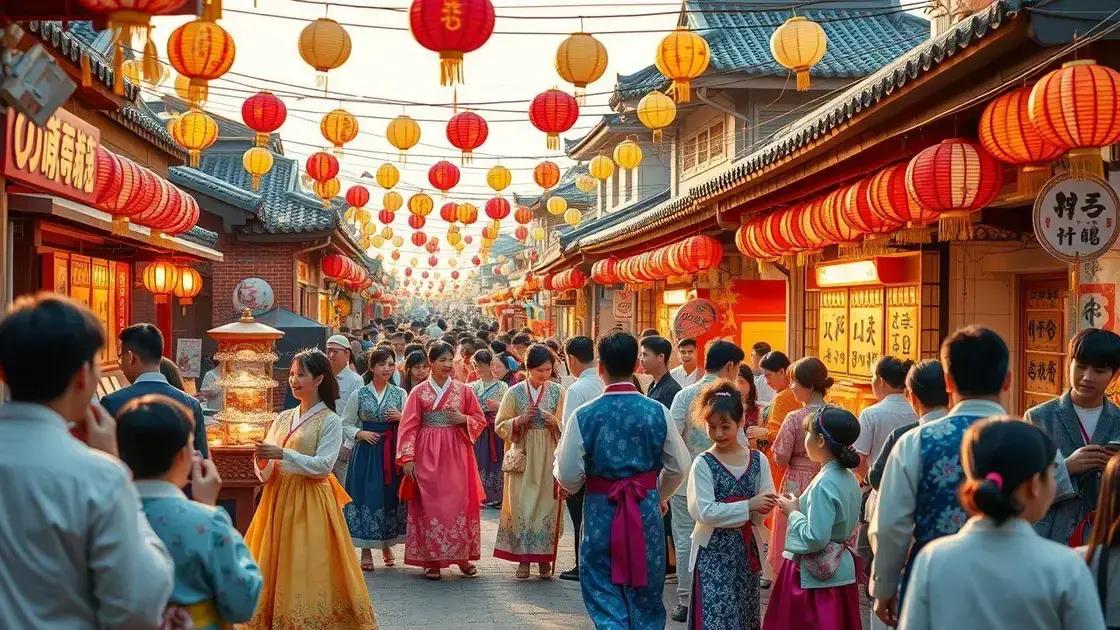
Participating in Korean festivals is an exciting way to experience vibrant culture and tradition firsthand. Whether you’re a local or a visitor, these occasions offer unique opportunities to engage with communities and learn about their customs.
Research and Plan Ahead
Before attending a festival, it’s helpful to research the specific event. Knowing the date, location, and key activities can enhance your experience. Popular festivals like Chuseok and Seollal occur ON fixed dates each year, so planning ahead is essential.
- Check local calendars and tourism websites for schedules.
- Find out about the festival’s history and significance.
- Identify any special events or performances you want to see.
Understanding what to expect can help you prepare for a fun and enriching experience.
Dress Appropriately
Wearing traditional Korean clothing, or hanbok, can add to the festive atmosphere. Many people wear hanbok during festivals, especially on Seollal and Chuseok. You can rent a hanbok for the day to immerse yourself fully in the experience.
Comfortable clothing is also essential, particularly during summer festivals when the weather can be hot. Make sure to wear comfortable shoes for walking.
Engage in Activities
During Korean festivals, many activities are open to public participation. You can enjoy traditional games, food tastings, and cultural performances. Don’t be shy about joining in!
- Try out local foods like songpyeon during Chuseok or tteokguk for Seollal.
- Participate in local dances or martial arts demonstrations.
- Join in on traditional games like yutnori or tuho.
Engaging in these activities not only enriches your experience but also allows you to connect with others who share a love for Korean culture.
Respect Local Customs
While you enjoy the festivities, be sure to respect local customs and traditions. Koreans value their cultural heritage, so observing etiquette is appreciated. For example, during ancestor rituals, it’s respectful to stand quietly and observe.
Being polite and courteous will foster goodwill with festival attendees and organizers, making for a positive experience.
FAQ – Frequently Asked Questions about Korean Festivals
What are some popular Korean festivals I should know about?
Some popular Korean festivals include Chuseok, Seollal, and Boknal, each celebrating unique cultural traditions.
How can I participate in a Korean festival as a visitor?
You can participate by attending the festivals, trying traditional foods, wearing hanbok, and engaging in various cultural activities.
Do I need to know the Korean language to enjoy the festivals?
No, you don’t need to know Korean. Many festivals have signs and information in English, and locals are usually friendly and accommodating.
What should I wear to a Korean festival?
Wearing comfortable clothes is important. Many people wear traditional hanbok during festivals, which you can rent to enhance your experience.

